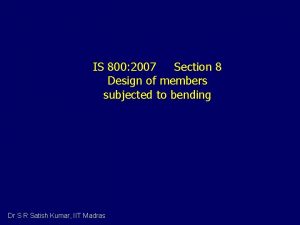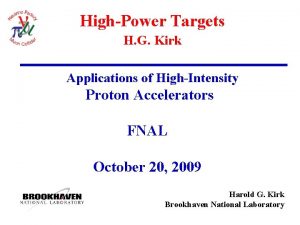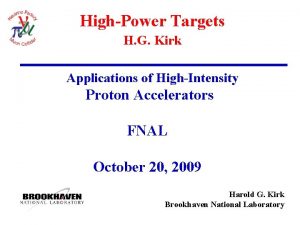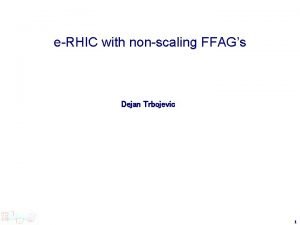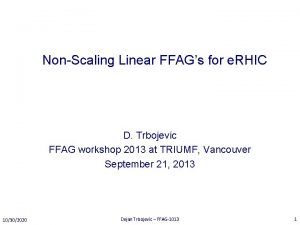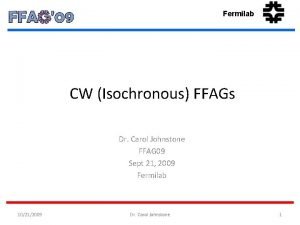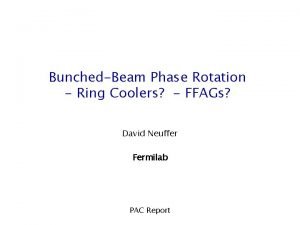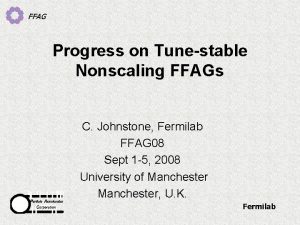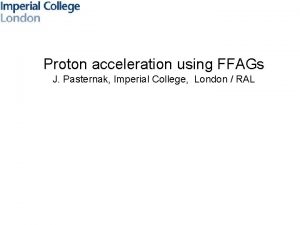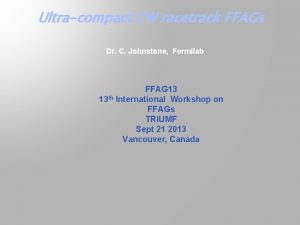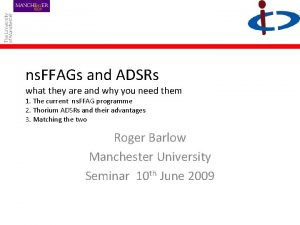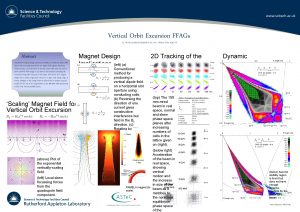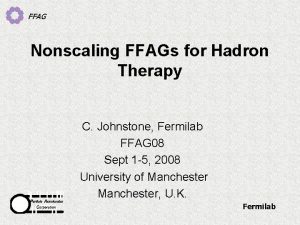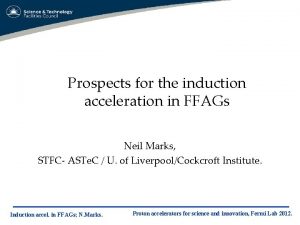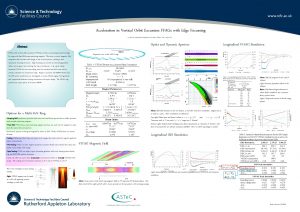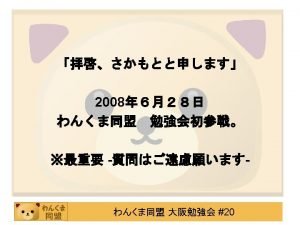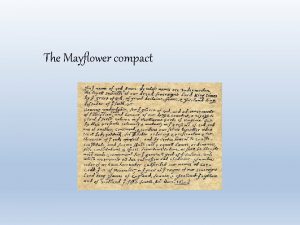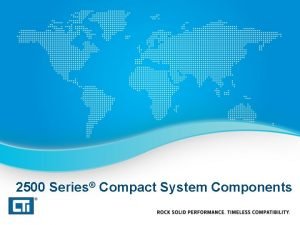Compact CW FFAGs for Highintensity Applications Dr C




































- Slides: 36

Compact CW FFAGs for High-intensity Applications Dr. C. Johnstone FFAG 14 22 rd Workshop on Fixed Field Alternating Gradient Accelerators Brookhaven National Lab Sept 21 -26 2014 Upton, NY

Outline � Motivation and Background Next generation high-energy fixed field accelerators Medical, security, energy applications CW FFAGs ; i. e. strong-focusing cyclotrons �Relativistic energies: ~200 Me. V – 1 Ge. V �Compact versions �Constant machine tunes (optimized gradients) �High m. A currents (low losses) � These machines require high gradient acceleration; and SCRF for high currents Compactness Low extraction losses � Large horizontal aperture of the FFAG, like the cyclotron, is a challenging problem for SCRF design 2

Cyclotrons: general comments � � � Cyclotrons are the highest current, most compact solution, but only up ~200 Me. V for protons As the energy becomes relativistic, orbit separation becomes smaller and smaller for CW operation Higher energies require separated sectors (like the 590 -Me. V PSI or 500 -Me. V TRIUMF machines) – in order to insert strong accelerating (RF) systems. Stronger acceleration is required to minimize beam losses and radioactivity particularly during beam extraction � Fewer acceleration turns and larger between different acceleration orbits facilitate efficient extraction. � � � However, once space is inserted between the magnetic sectors of the cyclotron, the footprint grows rapidly. At relativistic energies, above 200 Me. V, cyclotrons do not scale. Field profile must be nonlinear at relativistic energies for CW operation

Tunes in a relativistic ultracompact cyclotron � One of the most important indicators of stability is called machine tune; the no. of oscillations a particle makes about the energy-specific reference orbit in one translation around the ring � The tune in a cyclotron must vary as it enters relativistic energies. A gradient must be imposed to keep the beam CW Predicted tune from an ultracompact medical cyclotron(left) and ZGOUBI (middle) and COSY (right). . Predicted problems are marked with red arrows

So what is a FFAG? Next generation cyclotron A Fixed Field Alternating Gradient Accelerator is a ~ a cyclotron with strong synchrotron-like focusing • The ns-FFAG combines all forms of transverse beam (envelope) confinement in an arbitrary, optimized magnet field: – For the horizontal, the three terms are synchrotron – cyclotron The power of the FFAG is that the confinement terms can be varied independently to optimize machine parameters such as footprint, aperture, and tune in a FFAG AND DC beam can be supported to very high energies

The international FFAG collaboration Accelerator Science and Technology Centre 6

� Quick Guide to Fixed-Fielding Alternating Gradient FFAGs Simplest Dynamical Definition: FFAG is ~ a cyclotron with a gradient; beam confinement is via: � Strong alternating-gradient (AG) focusing, both planes: radial sector FFAG � Gradient focusing in horizontal, edge focusing in vertical: spiral sector FFAG � � vertical envelope control is through edge focusing (like a cyclotron) the normal gradient increases edge focusing with radius /momentum (unlike a cyclotron) A cyclotron can be considered the lowest-order FFAG � � normal/reversed gradients alternate (like a synchrotron) Types of FFAGs: Scaling: � B field follows a scaling law as a function of radius - rk (k a constant; ) presentday scaling FFAGs: Y. Mori, Kyoto University Research Reactor Institute Nonscaling: � Linear (quadrupole) gradient; beam parameters generally vary with energy (EMMA FFAG, Daresbury Laboratory, first nonscaling FFAG) Nonlinear-gradient; beam parameters such as machine tune can be fixed (as in a synchrotron)

FFAGs and their Variations Scaling FFAGs (spiral or radial -sector) are characterized by geometrically similar orbits of increasing radius, imposing a constant tune (field and derivative gradient scale identically with r). Magnetic field follows the law B rk, with r as the radius, and k as the constant field index. Spiral Sector: example: more compact; positive bend field only. Vertical focusing controlled by edge crossing angle. Field expansion: k determines multipole order; Comments: the lower the k value, the more slowly field increases with r and the larger the horizontal aperture, but the more linear the field composition and dynamics. F D D Radial Sector: example: This is a triplet DFD cell; there also FDF, FODO and doublets. In a radial sector the D is the negative of the F field profile, but shorter.

Understanding a ns-FFAG Ø Ø Apply a “synchrotron” strong-focusing field profile to each “cyclotron” orbit Strong-focusing allows Long injection/extraction or synchrotron-like straights Ø Strong RF acceleration modules Ø Low –loss profile of the synchrotron Ø DC beam to high energies in compact structure Ø Ø 400 Me. V/nucleon: charge to mass of ½ (carbon) Ø 1. 2 Ge. V protons Ø Avoidance of unstable beam regions Ø constant machine tune straight = CONSTANT MACHINE TUNES AT NEAR AND FAR RELATIVISTIC ENERGIES UNLIKE A CYCLOTRON

Relativistic CW (DC-beam) ns-FFAGs NS FFAG can maintain isochronous orbits at relativistic energies ü ü ü Pathlength of isochronous orbits are proportional to velocity Orbits as a function of momentum follow, therefore the B field must scale with velocity At relativistic energies, momentum is an increasingly nonlinear function of velocity; therefore B field transitions from a linear slope to nonlinear, non-relativistic to relativistic as an approximate function of radius. THIS HAS BEEN ACHIEVED IN RECENT NONLINEAR NS FFAG DESIGNS Nonlinear field expansion + edge angle can constrain the tune Nonlinear gradient provides very strong focusing at high energy in both 3500 planes relative to the cyclotron FFAG limit 3000 Cyclotron limit ~ 1 Ge. V protons P (Me. V/c) ü <Br> p/β for isochronous orbits ≥ 2 Ge. V protons 2500 2000 1500 1000 500 or normalized path length 0 0 0, 5 1 1, 5

INTERNATIONAL DEVELOPMENT OF FFAGS RACCAM: proton therapy ERIT: neutron source PRISM: intense muon beam Lepton flavor violation exp. LPSC Grenoble, France KURRI, Japan Osaka, Japan PAMELA: hadrontherapy design Oxford, U. K. KURRI: ADS test Kyoto U. Research Reactor Institute, Japan ~4 m 0. 2 -1 Ge. V intense proton FFAG (ADS) Compact Racetrack Injection extraction RF ~6 m POP, 1 st p FFAG, KEK, Japan Compact CW ns-FFAG racetrack design capable of variable energy and various applications EMMA: POP muon acc demo Daresbury Laboratory, U. K.

Advanced design and simulation of an Isochronous 0. 25 -1 Ge. V Nonscaling FFAG 2 m General Parameters of an initial 0. 250 – 1 Ge. V non-scaling, nearisochronous FFAG lattice design Parameter Avg. Radius (m) Cell x / y (2 rad) Ring. Field F/D (T) Magnet Size F/D Inj 250 Me. V 3. 419 0. 380/0. 237 1. 520/0. 948 1. 62/-0. 14 1. 17/0. 38 585 Me. V 4. 307 1000 Me. V 5. 030 0. 400/0. 149 1. 600/0. 596 0. 383/0. 242 1. 532/0. 968 2. 06/-0. 31 2. 35/-0. 42 1. 59/0. 79 1. 94/1. 14 ENORMOUS DYNAMIC APERTURE WITH THESE MACHINES constant strong-focusing machine tune – NO RESONANCES ARE CROSSED

Advanced design and simulation of an Isochronous 0. 25 -1 Ge. V Nonscaling FFAG 2 m General Parameters of an initial 0. 250 – 1 Ge. V non-scaling, nearisochronous FFAG lattice design (±~3% TOF variation) Parameter Avg. Radius (m) Cell x / y (2 rad) Ring. Field F/D (T) Magnet Size F/D Inj 250 Me. V 3. 419 0. 380/0. 237 1. 520/0. 948 1. 62/-0. 14 1. 17/0. 38 585 Me. V 4. 307 1000 Me. V 5. 030 0. 400/0. 149 1. 600/0. 596 0. 383/0. 242 1. 532/0. 968 2. 06/-0. 31 2. 35/-0. 42 1. 59/0. 79 1. 94/1. 14 ENORMOUS DYNAMIC APERTURE WITH THESE MACHINES constant strong-focusing machine tune – NO RESONANCES ARE CROSSED

Design of an Isochronous 0. 3 -1 Ge. V DFD FFAG with space charge 2 m Vertical magnetic field from 0. 33 -1 Ge. V in 80 Me. V steps and variation of cell tunes using OPAL in 20 Me. V steps General Parameters of an initial 0. 3 – 1 Ge. V isochronous FFAG lattice design (± 0. 5% TOF variation) Variation cell tunes / OPAL in 20 Me. V steps Preliminary Design – a resonance is crossed at 617 Me. V which needs to be addressed

Simulation of an Isochronous 0. 3 -1 Ge. V DFD FFAG with space charge S. Sheehy/A. Adelmann Emittance variation at 330 Me. V (left) and 610 Me. V (right) for fixed energy tracking (no acceleration) with space charge for 0 – 10 m. A and a 100 mm long single bunch With no longitudinal focusing the bunch expands in length but space charge has little impact on transverse emittance due to strong focusing

Simulation of an Isochronous 0. 3 -1 Ge. V DFD FFAG with space charge S. Sheehy/A. Adelmann Serpentine channel for = 4=3 contours plotted for regularly spaced values of x=y. Maximum serpentine acceptance in degrees for varying voltage per turn and harmonic number. Turn-by-turn radial position vs energy for a low intensity beam in the serpentine channel accelerated to 500 Me. V.

Compacting the FFAG Ø Ø The footprint of CW/DC FFAG accelerators is decreasing rapidly Light Nb. Sn/Nb. Ti self-shielding SC magnets are under design A conceptual design for a SC RF pillbox cavity design (50 cm x 5 cm) has been completed and achieves 10 MV/m Stable – no resonance crossing machine tunes Strong-focusing tunes: r = 1. 3 x=0. 7 RLA FFAG is stable !

FFAG Tracking summary: 3. 7 m radius, 4 -cell; 4 x 2 m straights Stable beam area @injection (200 Me. V) Stable beam area @500 Me. V Stable beam area @1000 Me. V Tracked: 24 cm x 240 mr = 57, 600π mm-mr norm = 39, 460π mm-mr Tracked: 36 cm x 225 mr = 81000π mm-mr norm = 94, 132π mm-mr Tracked: 39 cm x 150 mr = 58, 500π mm-mr norm = 105, 824π mm-mr 300 mr 520 mm Stable horizontal Beam size vs. Energy, tracked in 3 cm steps Stable beam area @injection (200 Me. V) Stable beam area @500 Me. V Stable beam area @1000 Me. V Tracked: 30 mm x 8 mr = 240π mm-mr norm =165π mm-mr Tracked: 33 mm x 6 mr = 198π mm-mr norm =229π mm-mr Tracked: 30 mm x 4 mr = 120π mm-mr norm =216π mm-mr 10100 mrmr 40 mm Stable Vertical Beam size vs. Energy: tracking ends at ± 1 cm, vertical magnet gap, tracked in 3 mm steps

FFAG Tracking summary: 1. 2 m ext. radius, racetrack Stable beam area @injection (200 Me. V) Stable beam area @500 Me. V Stable beam area @1000 Me. V Tracked: 8 cm x 293 mr = 23440π mm-mr norm = 16, 059π mm-mr Tracked: 12 cm x 220 mr = 26400π mm-mr norm = 30680π mm-mr Tracked: 13 cm x 165 mr = 21450π mm-mr norm = 38802π mm-mr 330 mr 180 mm Stable horizontal Beam size vs. Energy Stable beam area @injection (200 Me. V) Stable beam area @500 Me. V Stable beam area @1000 Me. V Tracked: 10 mm x 9 mr = 90π mm-mr norm =62π mm-mr Tracked: 11 mm x 7 mr = 77π mm-mr norm =89π mm-mr Tracked: 10 mm x 5 mr = 50π mm-mr norm =90π mm-mr 10100 mrmr 15 mm Stable Vertical Beam size vs. Energy: tracking ends at ± 1 cm, vertical magnet gap

ZGOUBI simulations of the circular FFAG Haj-Tahar Malek Periodic betatron functions vs energy at azimuthal angle =0. – analytical model.

Comparing fixed-field Dynamic Apertures FFAG Stable beam area @200 Me. V vs DA of ultracompact 250 Me. V cyclotron 80 mm x 293 mr 10 mm x 9 mr V = 90π mm-mr norm =62π mm-mr H = 23, 440π mm-mr norm = 16, 059π mm-mr FFAG: Horizontal – 1 cm steps FFAG: Vertical – 1 mm steps FFAG Stable beam area @1000 Me. V vs. DA of 800 Me. V Dae alus cyclotron*: factor of 4 larger for ~ a factor of 4 smaller footprint Tracked: 130 mm x 165 mr = 21450π mm-mr norm = 38820π mm-mr Tracked: 10 mm x 5 mr = 50π mm-mr norm =90π mm-mr *FFAG vert. stable area at aperture limits. *F. Meot, et. al. , Proc. IPAC 2012

MAGNETS and modeling Parameter Units Number of magnets 6 Number of SC coils 12 Peak magnetic field on coils T 7 Magnet Beam Pipe gap mm 50 Superconductor type <3 m Operating Temperature Nb. Ti K Superconducting cable <5 m One straight section occupied by RF cavities and injection/extraction in the other Value 4. 0 Rutherford Coil ampere-turns MA 3. 0 Magnet system height M ~1 Total Weight tons ~10 The magnetic field is relatively flat under the F-pole but the angular field length strongly depends on the radius providing the needed range from injection to extraction. The return flux provides the D or reverse gradient but needs careful optimization 22

Racetrack layout � � Start with the 2 m straight, 3. 7 m radius, ~2 T fields Remove 2 m straights from sides and add to two opposing straights 12 m. 8 m. 4 m. Layout of racetrack FFAG for simulations and half arc layout. Py. Zoubi tracks.

Circular vs Racetrack simulations using Py. Zgoubi/ R. Appleby Machine tunes for the 2 m ring (left) and the mini-racetrack FFAGs (right) as a function of beam energy. . Dynamic Horizontal Vertical aperture π. mm. mrad 200 Me. V 40 turns 200 Me. V 200 turns 800 Me. V 40 turns 74700 107 72600 91 156300 364 155100 356 800 Me. V 200 turns aperture π. mm. mrad 200 Me. V 40 turns 200 Me. V 200 turns 800 Me. V 40 turns 25000 46 23700 43 63000 277 800 Me. V 200 turns 63000 223 Very preliminary unnormalized DA for circular (left) and racetrack (right) computed with Py. Zoubi

Error Analysis: Circular vs Racetrack - R. Appleby � Racetrack is showing similar stability to misalignments and errors The relative drop in dynamic aperture as a function of misalignment for the circular 2 m straights FFAG (left and the 4 m straights racetrack (right) computed with Py. Zgoubi. .

Observations � � � DA of a FFAG cyclotron for medium energies (~100 -200 Me. V) and equivalent footprint DA aperture for these new constant-tune isochronous FFAGs are large – tens of thousands of mm-mr (normalized) DA scales almost completely geometrically with size of the machine – ultracompact FFAGs show identical dynamical stability

Design specifications � � � Large horizontal beam aperture of 50 cm Cavity should operate at 150 or 200 MHz (harmonic of the revolution frequency) Should provide at least 5 MV for proton beam with energies 200 – 900 Me. V Peak magnetic field should be no more than 160 m. T (preferably, 120 m. T or less) Peak electric field should be minimized Cavity dimensions should be minimized FFAG cavity September 16, 2013 27

Cavity options Beam � Half-wave trajectories resonator Resonators HWR is very dependent on particle velocity Can’t be used efficiently for such a wide range of particle energies May 13, 2013 H- Dimensions are very large as is peak magnetic field on the electrode edge FFAG cavity 28

Rectangular Cavity � � � Rectangular cavity operating at H 101 mode has electric field concentrated in the center of the wall To concentrate electric field at beam aperture, we introduced tapers To reduce peak magnetic field the blending was introduced Beam direction W H L 29

Gap and Frequency Optimization The voltage at 160 m. T maximum field dependence on gap length was calculated for cavities with different frequencies and lengths Beam Energy = 200 Me. V Voltage in the center of the aperture Peak magnetic field = 160 m. T 150 MHz 1. 5 m structure has a potentially higher possible voltage or lower peak magnetic field at 5 MV 200 MHz structure is more compact May 13, 2013 FFAG cavity 30

Cavity shape optimization � � A taper was introduced to distribute the magnetic field over a larger volume keeping the electric field concentrated around the beam aperture Such a cavity design has smaller dimensions for the same volume All edges were rounded and improved reentrant nose shape reduced the peak magnetic field by more than 15% and the transverse dimensions by more than 10 cm Final study was an elliptical cell shape where the magnetic field varies along the cavity wall such that there are no stable electron trajectories and multipacting is inhibited 31

Comparison of different cavity geometries Parameters of the different cavity designs. Parameter Frequency, MHz Rectangular top 200 Rectangular middle 200 Elliptical bottom 200 Length, cm 100 120 Height, cm 104. 5 92. 9 142 Voltage (β=0. 56, edge), MV 4. 67 4. 66 4. 68 Voltage (β=0. 78, center) , MV 6. 72 6. 71 6. 89 Voltage (β=0. 86, edge) , MV 5. 00 R/Q (β=0. 86, edge), Ohms 82. 8 89. 7 75. 0 G, Ohms 147. 9 150. 2 134. 2 Peak magnetic field, m. T 92. 1 72. 7 77. 2 Peak electric field, MV/m 55. 2 47. 0 48. 1 The RF performance degrades at higher frequencies. � Rectangular cavity is better than elliptical by all parameters except multipactor resistivity May 13, 2013 FFAG cavity 32

RF input coupler design � As 1 m. A beam is accelerated by 4 cavities from 200 to 900 Me. V, each cavity requires about 175 k. W of power � One of the options is to attach 2 100 k. W couplers to the cavity 80 K 4 K 126 K 300 K 133 K Heat Flows: To 4 K = 9. 8 W To 60 K = 92. 0 W From 300 K = 18. 8 W ANSYS estimations show no significant overheating May 13, 2013 FFAG cavity 33

Magnetic power coupling and mechanical design � � External Q-factor should be ~ 1. 9*106 Preliminary results predict ~1. 1 mm Nb and ~0. 6 mm SS deformation at magnetic field area The complete mechanical design: 1 – niobium shell, 2 – RF ports, 3 - extra ports, 4 – frequency tuning, 5 – steel jacket, 6 – rails 34

SCRF DESIGN: 10 MV/M; 50 CM X 5 CM (WXH) RF input coupler Mechanical design: Nb shell and port layout He jacket Rectangular (Fig. 1. 3 c) (Fig. 1. 6) Elliptical Parameter left middle right Frequency, MHz 200 200 Length, cm 100 120 Height, cm 104. 5 92. 9 142 Voltage (β=0. 56, edge), 4. 67 4. 66 4. 68 6. 72 6. 71 6. 89 5. 00 82. 8 89. 7 75. 0 G, Ohms 147. 9 150. 2 134. 2 Peak magnetic field, m. T 92. 1 72. 7 MV Voltage (β=0. 78, center) , MV Voltage (β=0. 86, edge) , MV First and final optimized rectangular cavity shape (left, middle left) and surface magnetic field profile (middle right) and elliptical cavity (right). R/Q (β=0. 86, edge), Ohms Peak electric field, MV/m 55. 2 47. 0 77. 2 35 48. 1

• • Summary The ns. FFAG has evolved to an isochronous, high energy, high current application With constant strong-focusing machine tunes and optics that are independent of energy • • • No resonance crossing The DA aperture is 10, 000 – 100, 000 mm-mr depending on size and tunes In the relativistic regime, the FFAG becomes more compact than the separated sector cyclotron and more stable if designed properly • The racetrack is the most compact Large aperture high-gradient cavities including SCRF have been designed Ironless, self-supported coil SC magnets are also being developed
 Plastic compact semi compact slender
Plastic compact semi compact slender Var 1721 för stormaktssverige
Var 1721 för stormaktssverige Jag har nigit för nymånens skära
Jag har nigit för nymånens skära Tack för att ni har lyssnat
Tack för att ni har lyssnat Anatomi organ reproduksi
Anatomi organ reproduksi Referatmarkering
Referatmarkering Novell typiska drag
Novell typiska drag Karttecken brant
Karttecken brant Samlade siffror för tryck
Samlade siffror för tryck Klassificeringsstruktur för kommunala verksamheter
Klassificeringsstruktur för kommunala verksamheter Hur skriver man en debattartikel
Hur skriver man en debattartikel Elektronik för barn
Elektronik för barn Påbyggnader för flakfordon
Påbyggnader för flakfordon En lathund för arbete med kontinuitetshantering
En lathund för arbete med kontinuitetshantering Borra hål för knoppar
Borra hål för knoppar Smärtskolan kunskap för livet
Smärtskolan kunskap för livet Bris för vuxna
Bris för vuxna Verifikationsplan
Verifikationsplan Frgar
Frgar Ledarskapsteorier
Ledarskapsteorier Presentera för publik crossboss
Presentera för publik crossboss Humanitr
Humanitr Steg för steg rita
Steg för steg rita Förklara densitet för barn
Förklara densitet för barn Toppslätskivling dos
Toppslätskivling dos Redogör för vad psykologi är
Redogör för vad psykologi är Nationell inriktning för artificiell intelligens
Nationell inriktning för artificiell intelligens Geometriska former i förskolan
Geometriska former i förskolan Upprepning dikt
Upprepning dikt Mjälthilus
Mjälthilus Autokratiskt ledarskap
Autokratiskt ledarskap Vad kallas den mantel som bars av kvinnor i antikens rom
Vad kallas den mantel som bars av kvinnor i antikens rom Kraft per area
Kraft per area Vilken grundregel finns det för tronföljden i sverige?
Vilken grundregel finns det för tronföljden i sverige? Personalliggare bygg undantag
Personalliggare bygg undantag Ministerstyre för och nackdelar
Ministerstyre för och nackdelar Big brother rösta
Big brother rösta
